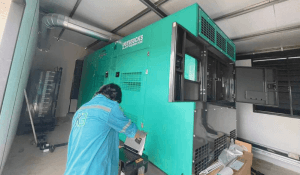
All industries are now compelled to produce energy sustainably, regardless of their market demand, because we have the unfortunate problem of human-induced climate change. One key point that anti-global warming movements have made, and which has genuinely been somewhat useful for a while, is this: There exist generating technologies that emit less greenhouse gas than others do, and that are capable of providing baseload energy.
Note: Wondering how electric generators can benefit your business? Visit www.k3machine.co.th for comprehensive articles and expert insights. Discover everything you need to know to make informed decisions about generator technology today!
The problem is that those generating technologies are not the ones that society is currently using at an electric plant near you. This article is aimed at something a little different than pointing the finger at bad choices society has made when it comes to greenhouse-gas budgeting. It’s about base load generating technologies that do a good job of keeping society’s electric plants in good working order without unduly emitting a slew of greenhouse gasses.
Unscramble the concept of electromagnetic generators. Electromagnetic generator: The electromagnetic generator is entirely based on electromagnetic induction and uses mechanical power to convert into electrical energy following the basic principles of electromagnetic theory. If a conductor or wire coil were to move within a magnetic field, an electric current would flow as a result of this induction. So is this groundbreaking as a technological concept? Not really. It functions similarly to the way conventional energy production does, though on an atomic scale (which would be driven by coal or natural gas). However, whatever other unusual property we share is a different sort of electromagnetic generator in which to reside.
How Electromagnetic Generators Can Help Reduce GHGs Greenhouse gas emissions can be reduced in two main ways: improving energy efficiency and changing the way we produce and consume energy. The technology associated with electromagnetic generators does not directly influence energy efficiency, which mainly concerns using energy in a more efficient manner. However, it does significantly influence the way we produce and consume energy—in a cleaner manner, to put it more simply—compared to conventional power plants. When power is produced using electromagnetic generators, almost zero emissions are produced. Again, at this moment, it certainly seems like a science fiction scenario that would not be directly applicable to today’s society. When the technology behind the generators becomes more developed, capable, and accessible, the more productive electric energy there will be, and the less feasible electric energy production from the means causing many emissions and GHGs associated with climate change. Utility providers like oncor energy are also supporting this shift by integrating cleaner and more efficient energy solutions into the grid.
Renewable power source compatibility is another highlight. It will save you green in more ways than one. Placing suitable devices in a sink of renewable energy can improve the power and performance of such devices while providing robust security. But how feasible is using non-emitting devices in places like the refrigerator? Imagine if electric cooling could work without refrigerants, for instance, and how electric vehicles could work without emitting greenhouse gasses. Water power from appropriately sited hydroelectric systems and wind power from suitable turbines could together electrify a substantial portion of the world.
Move to Clean Power Plants Western countries and those in Asia are still pouring investment into new coal and gas-fired power plants, according to Adair Turner, who chairs the WWF climate change program. Regardless of what happens upstream, our household and local grid power generation is by far the single most pivotal way to cut our emissions. Power plants are simply electric money machines that use whatever they have on hand to pump out dirty electrons. The alternatives to these plants are not limited to putting a solar panel on every rooftop, as nice a proposition as that is. A far better, and precisely what the WWII aviators were talking about, is to put every available solar panel into the clean power plant.
Broader Ecological Advantages
1. Minimal Operational Impact
Apart from these ecological advantages, many of the generating types would have little, if any, effect on the operations of the electromagnetic generators and similar devices — almost any kind, really. Take wind turbines, for example. They are either noise-polluting monsters that threaten the coexistence of humans and birds or safe, silent devices that don’t look much different from the windmill they replaced. And in either case, they require so much machinery, material, and labor to produce and maintain that they could never be considered an ecological way to generate electricity.
2. Decreased Levels of Air and Water Pollution
One might observe that electromagnetic generators are free of pollution. This assertion deserves some unpacking. Generally speaking, the creation of electrical power through the use of gas or water (most commonly by damming rivers, for instance, and with hydrofracking, wherein one diverts a river’s water to a turbine, etc.) tends to produce *some* air & water pollution. In contrast, the primes of renewable energy sources tend to be cleaner. The International Energy Agency expects that renewables and nuclear will be the only two types of technologies that will produce electricity without direct greenhouse gas emissions by 2030.
3. Advocating for the Circular Economy
Everywhere you go these days, the term “circular economy” is invoked. Sure enough, we appear to be embarking on a truly sustainable revolution. The circular economy is based on the following: reduction, reuse, and closed loops. These are familiar concepts. What is less obvious is how they might apply to the remodeling of the energy economy. Alternative energy models might be just as eco-sensitive, based on optimization of resources, and sustainable, in their way, as solar panels. But are the more eco-sensitive, resource-optimizing, and “sustainable” models of these energy-based practices really just as “circular” as the assembly line at Interface, Inc.?
Yes, it is indeed a cons **big and wide** for electromagnetic generators. They apparently are the best option we have as long as we can’t help but use them. But they are practically never competitive and wholly unhelpful as a local-only option almost everywhere that requires heating fuels or high EROI (energy return on investment) projects. Where mountain wind, for example, could be accessed by a project like the one on HWY 15, it becomes far too costly to build out where people live due to how our established energy-use infrastructure lies today. That, too, needs to change. Finally, funding and innovative research need to occur together to really drive costs down and make these projects likely accessible anywhere in the world within our lifetimes.
In some respects, this community serves to inform a beneficial proportion of the population, and is almost on the verge of raising awareness. But if several other communities do not understand the eminent BENEFIT of using electromechanical generators to achieve the goal of a carbon-free society and to create far more green electricity, then what good is this one community? After all, he is merely presenting VIDEO EVIDENCE of the REALITY that is his Electrical Magnetic generator, which WORKS in a fashion nearly indistinguishable from those methods they so ardently support.
The first half of this paragraph is so badly mangled that it’s hard to see what it’s saying. But it seems to be citing as “global evil” the use of fossil fuels (by public houses, no less). And it talks about the specter of food shortages as a result of using those fuels. The picture it paints is one of half-educated people doing things badly in the name of a barely comprehensible set of green principles.
The second half of the paragraph doesn’t get much clearer, though it does bring up the nasty game of “dirty electricity,” which is played by energy companies on all our circuits (not just the solar panels on our roofs that are part of half-baked green initiatives).





